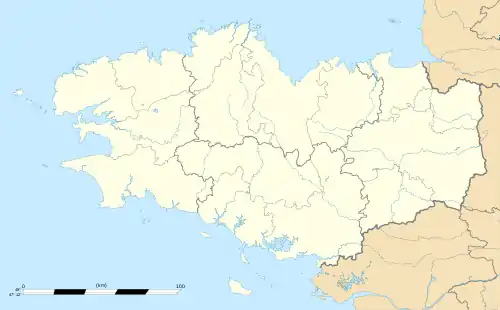Saint-Renan
Saint-Renan (French pronunciation: [sɛ̃ ʁnɑ̃]; Breton: Lokournan, pronounced [loˈkurnãn]) is a commune in the Finistère department of Brittany in north-western France.
Saint-Renan
Lokournan | |
|---|---|
 Two of the oldest buildings of downtown Saint-Renan in 2010. | |
.svg.png.webp) Coat of arms | |
Location of Saint-Renan 
| |
 Saint-Renan  Saint-Renan | |
| Coordinates: 48°25′54″N 4°37′14″W | |
| Country | France |
| Region | Brittany |
| Department | Finistère |
| Arrondissement | Brest |
| Canton | Saint-Renan |
| Intercommunality | Pays d'Iroise |
| Government | |
| • Mayor (2014–2020) | Gilles Mounier |
| Area 1 | 13.31 km2 (5.14 sq mi) |
| Population (2017-01-01)[1] | 8,110 |
| • Density | 610/km2 (1,600/sq mi) |
| Time zone | UTC+01:00 (CET) |
| • Summer (DST) | UTC+02:00 (CEST) |
| INSEE/Postal code | 29260 /29290 |
| Elevation | 26–97 m (85–318 ft) |
| 1 French Land Register data, which excludes lakes, ponds, glaciers > 1 km2 (0.386 sq mi or 247 acres) and river estuaries. | |
History
The city is named after the Irish saint "Ronan", who came in the 5th century to evangelize the area.
While Brest was a village, the city of Saint-Renan will develop throughout the Middle age. In 1276, the Duke of Brittany even established one of the court of justice there. Until the end of the 17th century, Saint-Renan is a big "Sénéchaussée" (the town of the seneschal) first ducal and then royal. It had a central place in the everyday life on inhabitants. A lot of buildings in the center town are from this period.
Population
Inhabitants of Saint-Renan are called Renanais in French.
|
|
|
Tourism
Old houses of 15th and 16th centuries are historical and architectural attractions.
Held every two years, the medieval festival of Saint-Renan, the biggest of the department, highlights the city's heritage. The 15th edition took place on the 15th and 16 July 2017.
The Saturday morning market - one of the biggest - is the opportunity to taste local products such as "kouign amann" (cake which name means "sugar and butter" in Breton language), Kig Ha Farz, algae, crepes, cider, caramel, and chitterlings sausages etc.
The six artificial lakes are part of the industrial heritage of the city, which nickname was "the European capital of pewter" in the 60s. The two largest ones, named "Ty Colo" and "Comiren" are perfect places for long relaxing walks.
The church of the 17th century has undergone several transformations over time. Built on top of a hill, its bell tower is visible from a large part of the city. The churchyard contains a military area dedicated to the British aviators from the Royal Air Force who died for freedom and for France during the World War II.
Breton language
In 2016, 14% of primary-school children attended bilingual schools, where Breton language is taught alongside French.[2]
Notable natives and residents
- Nolwenn Leroy, singer and songwriter, who rose to fame after winning the second series of the French television reality show, Star Academy.
- Benoît Hamon, politician, member of both the Socialist Party (“PS”), and the Party of European Socialists, candidate for the 2017 French Presidential Election.
See also
References
- "Populations légales 2017". INSEE. Retrieved 6 January 2020.
- http://www.opab-oplb.org/98-kelenn.htm
External links
| Wikimedia Commons has media related to Saint-Renan. |
- Official website (in French)
- Base Mérimée: Search for heritage in the commune, Ministère français de la Culture. (in French)
- Mayors of Finistère Association (in French)